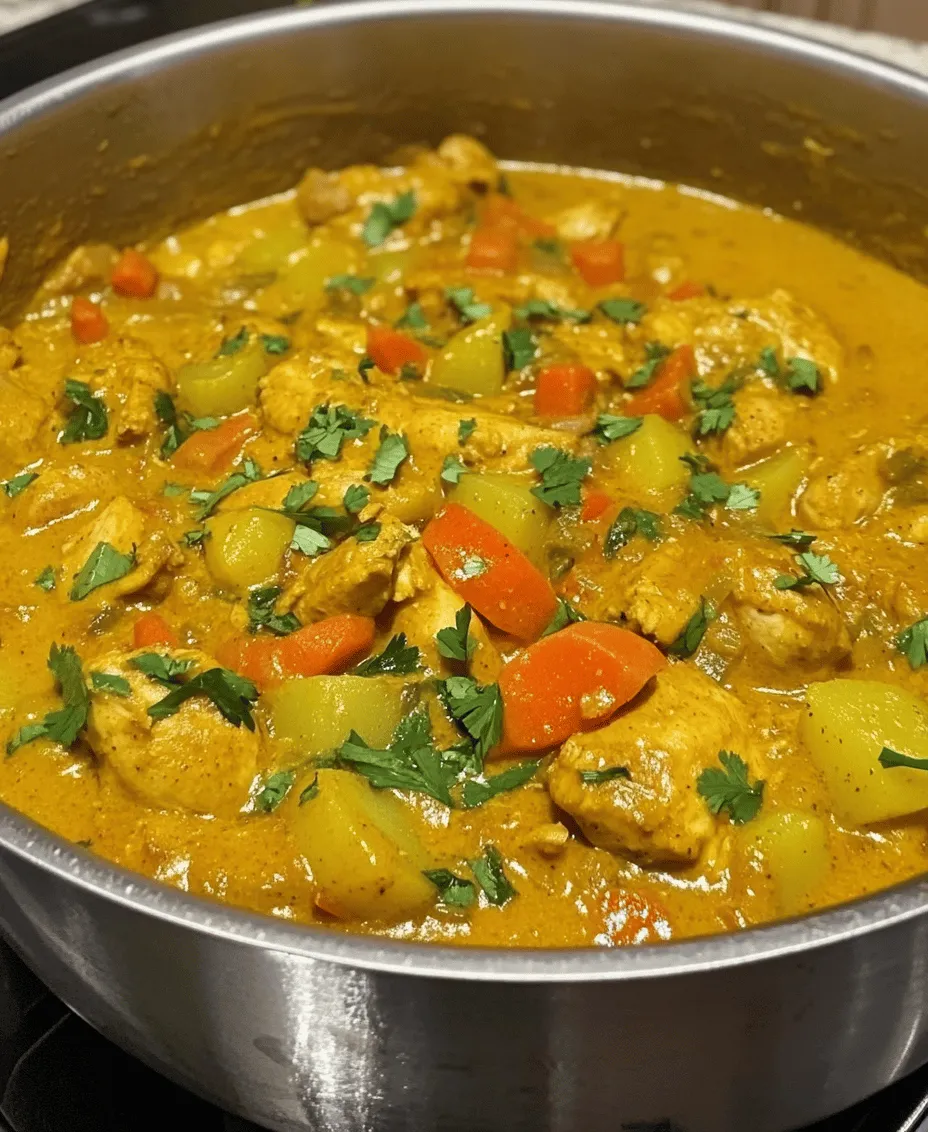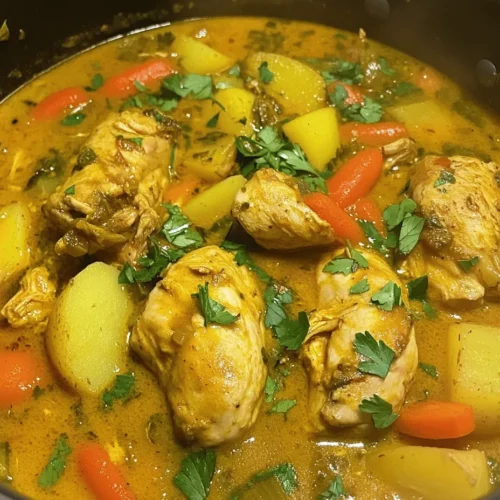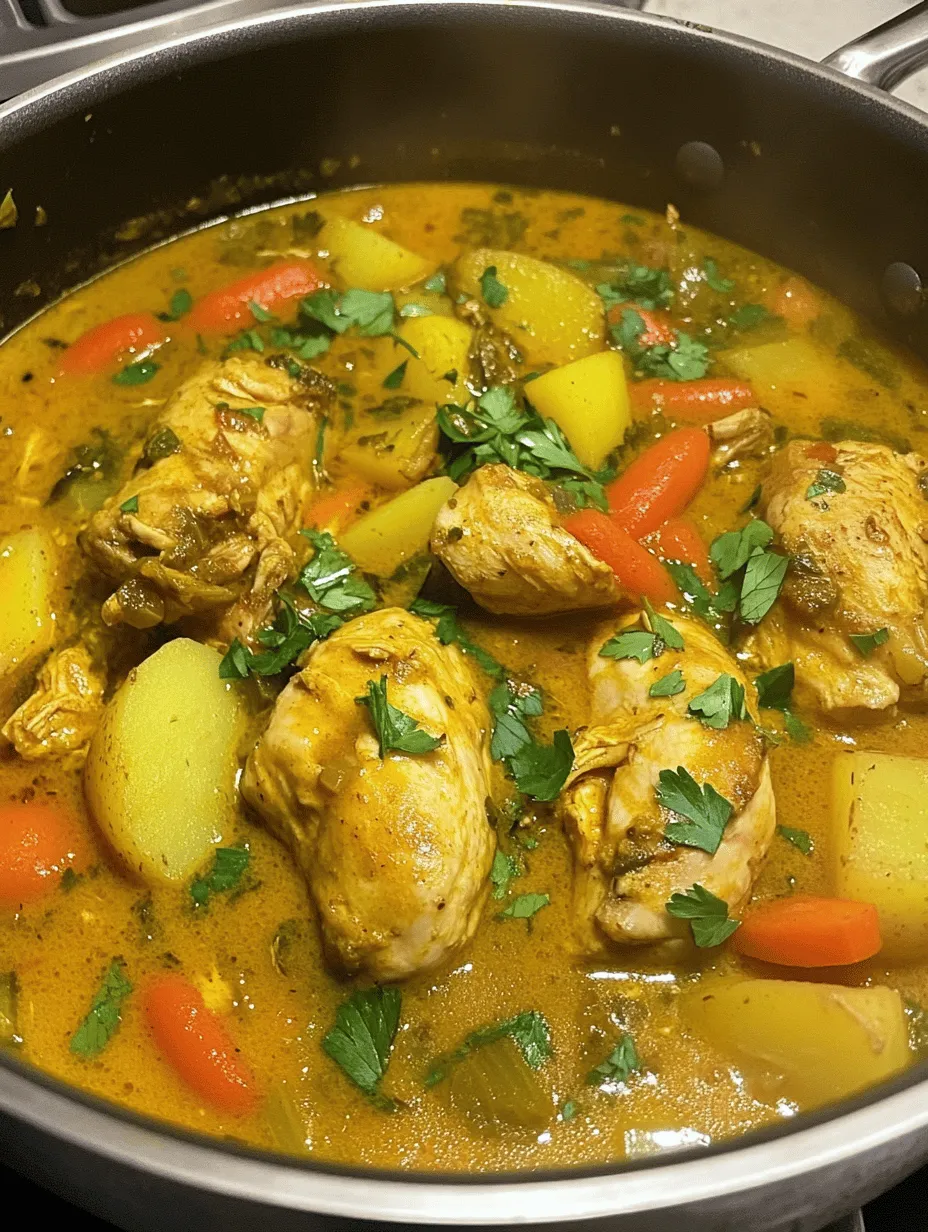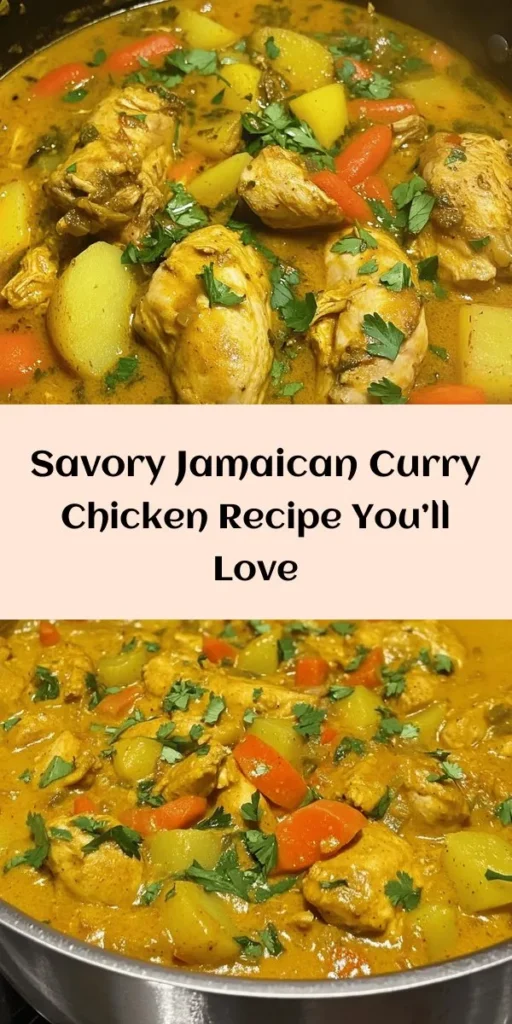Introduction
Jamaican cuisine is a vibrant tapestry woven from a rich history and diverse cultural influences, reflecting the island’s journey through colonization, migration, and the fusion of flavors. Renowned for its bold spices, hearty meals, and unique cooking techniques, Jamaican food holds a special place in the hearts of locals and visitors alike. One dish that stands out as a staple in many Jamaican households is curry chicken. This dish is not only a family favorite but also a symbol of celebration and togetherness in Jamaican culture.
Curry chicken embodies the essence of Jamaican cooking—it’s flavorful, aromatic, and deeply satisfying. When made with authentic ingredients and traditional methods, this dish becomes a culinary masterpiece that transports you straight to the sun-soaked shores of the Caribbean. In this article, we will delve into the rich history and cultural significance of Jamaican curry chicken, explore the key ingredients that contribute to its distinctive flavor, and provide a detailed guide on how to prepare this delightful dish.
Understanding Jamaican Curry Chicken
The history of curry in Jamaican cuisine is a fascinating reflection of the island’s multicultural past. Curry was introduced to Jamaica in the 17th century by Indian indentured laborers who brought with them a wealth of culinary knowledge and spices. Over time, these flavors blended with traditional Jamaican ingredients and cooking styles to create a unique fusion that is distinctly Jamaican.
Curry chicken is a beloved dish not only in Jamaica but throughout the Caribbean. Each island has its own version, influenced by local ingredients and culinary traditions. For example, in Trinidad, curry chicken might be served with roti, while in Jamaica, it is often paired with rice and peas or served alongside fried plantains. The dish’s popularity has spread beyond the Caribbean, with many people around the world embracing its rich flavors and comforting appeal.
What sets authentic Jamaican curry chicken apart is the careful selection of spices and cooking methods that elevate the dish to new heights. The use of fresh herbs, aromatic spices, and traditional techniques ensures that each bite bursts with flavor. Understanding the ingredients and their roles in the dish is essential for achieving that authentic taste.
Ingredients Breakdown
To create a truly authentic Jamaican curry chicken, it’s crucial to use the right ingredients. Each component plays a vital role in building the dish’s flavor profile. Let’s break down the key ingredients that make this dish so special:
Chicken
The star of the show is, of course, the chicken. For the best flavor and texture, it is recommended to use bone-in, skin-on chicken pieces. The bones not only add depth to the dish during cooking but also help to keep the meat tender and juicy. Common cuts include thighs, drumsticks, and even wings, as they are more flavorful compared to boneless, skinless options.
Jamaican Curry Powder
One cannot discuss Jamaican curry chicken without mentioning Jamaican curry powder. This spice blend is distinct from Indian curry powder, often featuring a unique mix of spices such as turmeric, coriander, cumin, and fenugreek, and sometimes even a hint of allspice. The flavor profile has a warm, mild heat that complements the chicken beautifully. Sourcing authentic Jamaican curry powder is essential, as many commercial varieties do not capture the true essence of this beloved dish.
Allspice
Allspice, known as “pimento” in Jamaica, is another essential ingredient that contributes to the dish’s depth of flavor. This aromatic spice has a warm, sweet flavor reminiscent of cinnamon, nutmeg, and cloves, making it a staple in Caribbean cooking. It is often used in both savory and sweet dishes, and its presence in curry chicken helps to create a complex flavor profile that is unmistakably Jamaican.
Fresh Herbs
The inclusion of fresh herbs is key to achieving the vibrant flavors characteristic of Jamaican cuisine. Thyme is a must-have in this recipe, adding a fragrant, earthy note that complements the spices. Additionally, scallions (green onions) provide a mild onion flavor and a touch of freshness. Both herbs should be added during the cooking process to infuse the dish with their aromatic qualities.
Scotch Bonnet Peppers
For those who enjoy a bit of heat, Scotch bonnet peppers are a staple in Jamaican cooking. Known for their intense heat and fruity flavor, these peppers can elevate any dish. When making authentic curry chicken, it’s important to use them judiciously, as they can be quite spicy. If you’re sensitive to heat, consider using a smaller amount or removing the seeds to tone down the spiciness while still retaining that characteristic flavor.
Vegetables
While chicken is the main attraction, a variety of vegetables also enhances the dish’s nutritional value and flavor. Common additions include potatoes, carrots, and bell peppers. Potatoes absorb the curry’s flavors while adding a creamy texture, while carrots and bell peppers provide a sweet crunch. These vegetables not only make the dish heartier but also offer a colorful presentation.
Coconut Milk
Coconut milk is a luxurious addition that brings creaminess to the curry chicken. It balances the spices and adds a subtle sweetness, creating a harmonious blend of flavors. Coconut milk is also commonly used in many Caribbean dishes, making it a familiar and comforting ingredient that enhances the overall experience.
Chicken Broth
To deepen the flavor of the curry, chicken broth is often used. It serves as a base for the sauce, adding richness and ensuring that the dish is well-seasoned. Homemade broth is ideal, but store-bought options can work in a pinch. When combined with the other ingredients, it helps to create a luscious sauce that clings to the chicken and vegetables.
Preparation Steps: A Detailed Guide
Now that we have a solid understanding of the ingredients that make up authentic Jamaican curry chicken, it’s time to dive into the preparation steps. Proper preparation is key to infusing the chicken with flavor and achieving the desired tenderness.
Marinating the Chicken
Marinating the chicken is an essential step that cannot be overlooked. This process allows the spices and flavors to penetrate the meat, resulting in a dish that is bursting with taste.
To begin, combine the chicken pieces with Jamaican curry powder, allspice, minced garlic, ginger, and a generous amount of salt in a large bowl. For an extra layer of flavor, consider adding lime juice and a splash of soy sauce. The acidity from the lime helps to tenderize the chicken while adding a bright, zesty flavor.
Once mixed, cover the bowl with plastic wrap or transfer the chicken to a resealable plastic bag to marinate. For optimal results, allow the chicken to marinate for at least 2 hours in the refrigerator. If time allows, let it marinate overnight for even more intense flavors.
In the next section, we will continue with the cooking process, exploring how to bring these flavors to life and create a dish that delights the senses and transports you to the heart of Jamaica.

Sautéing the Aromatics
Sautéing the aromatics is a crucial step in creating an authentic Jamaican curry chicken. The process begins with heating a generous amount of oil in a large skillet or Dutch oven over medium heat. Once the oil is shimmering, it’s time to add the finely chopped onions, garlic, and ginger. These ingredients not only serve as the foundation of the dish but also create a fragrant base that infuses the chicken with flavor.
Techniques for Achieving the Perfect Sauté
To achieve the perfect sauté, it’s essential to ensure that the heat is just right. If the heat is too high, the aromatics may burn, leading to a bitter flavor. Conversely, if the heat is too low, the aromatics will release their flavors too slowly, resulting in a lackluster dish. Aim for a golden-brown color on the onions, which typically takes about 5-7 minutes. Stir the mixture frequently to prevent sticking and ensure even cooking.
A great technique is to add a pinch of salt early in the sautéing process. This helps draw moisture from the onions, allowing them to cook evenly and become tender. As the onions become translucent and start to caramelize, the kitchen will be filled with an inviting aroma, setting the stage for the rich flavors to come.
How Aromatics Enhance the Dish’s Overall Flavor Profile
The combination of onions, garlic, and ginger not only adds depth and complexity to the curry but also enhances the overall flavor profile. Each ingredient contributes its unique characteristics: onions provide sweetness, garlic adds a savory punch, and ginger contributes a warm, spicy undertone. Together, they create a harmonious blend that forms the backbone of the curry, ensuring every bite is bursting with flavor.
Browning the Chicken
Once the aromatics are perfectly sautéed, it’s time to brown the chicken. This step is essential as it adds depth of flavor and creates a beautiful color that enhances the dish’s visual appeal.
Importance of Browning for Depth of Flavor
Browning the chicken is not just about aesthetics; it plays a pivotal role in flavor development. When chicken is seared, the Maillard reaction occurs, creating complex flavor compounds that elevate the dish. This process caramelizes the natural sugars in the chicken, resulting in a rich, savory crust that enhances the overall taste of the curry.
Tips on Achieving a Perfect Sear
To achieve a perfect sear, ensure that the chicken pieces are patted dry with paper towels before adding them to the hot skillet. This removes excess moisture, allowing for better browning. Additionally, avoid overcrowding the pan; cook the chicken in batches if necessary. This ensures that each piece has enough space to sear properly rather than steam.
Cook the chicken undisturbed for about 5 minutes on each side until golden brown. Once browned, it’s important to remove the chicken from the skillet and set it aside. This will help retain its juices and prevent overcooking, as the chicken will continue cooking in the sauce later.
Incorporating Vegetables
With the chicken browned and set aside, it’s time to add vegetables to the curry. Vegetables not only add nutritional value but also contribute to the dish’s texture and flavor.
Best Practices for Adding Vegetables Without Losing Texture
When incorporating vegetables, consider their cooking times. For example, denser vegetables like carrots and potatoes should be added first, as they take longer to soften. After a few minutes, you can add quicker-cooking vegetables like bell peppers and green beans.
To maintain their texture, avoid overcooking the vegetables. Aim for a tender-crisp consistency, allowing them to retain some bite. Stirring them into the aromatic base before adding the chicken and liquid helps to coat them in the flavorful mixture.
How to Balance Flavors with the Right Vegetable Combinations
Balancing flavors with vegetable combinations is key to a well-rounded dish. For Jamaican curry chicken, consider using traditional Caribbean vegetables such as bell peppers, carrots, and even sweet potatoes. These not only add sweetness and color but also complement the spices in the curry beautifully.
Feel free to customize the vegetables based on what’s available or your personal preferences. Just ensure that the flavors harmonize with the dish’s overall profile. For example, adding fresh thyme or scallions can enhance the dish’s aroma and give it a refreshing twist.
Simmering Low and Slow
Simmering is a vital step in developing the flavors of your Jamaican curry chicken. After adding the browned chicken back into the pot, it’s time to incorporate the curry powder and coconut milk.
Explanation of the Simmering Process and Its Impact on Flavor Development
Simmering allows the flavors to meld and deepen. As the chicken cooks slowly in the aromatic sauce, it absorbs all the spices and ingredients, resulting in a rich and satisfying dish. The gentle heat ensures that the chicken remains tender and juicy, while the coconut milk adds creaminess and balances the heat from the spices.
Recommended Cooking Times for Optimal Tenderness
For the best results, cover the pot and let the curry simmer on low heat for about 30-40 minutes. This cooking time allows the chicken to become fork-tender and ensures that the flavors develop fully. If using bone-in chicken, you may need to extend the cooking time slightly, as it requires longer to become tender. Always check for doneness by ensuring the chicken reaches an internal temperature of 165°F.
Adjusting Seasoning for Personal Taste
As the curry simmers, it’s essential to taste and adjust the seasonings. This step is crucial for achieving a dish that resonates with your palate.
Guidelines on How to Taste and Adjust Seasonings
Start by tasting the curry about halfway through the cooking process. This allows you to gauge the flavors and decide if more salt, pepper, or spices are needed. If you prefer a spicier curry, consider adding more curry powder or a splash of hot sauce.
Remember, seasoning adjustments can make a significant difference. If the curry tastes flat, a squeeze of lime juice or a dash of vinegar can brighten the flavor. Conversely, if it’s too spicy, a bit more coconut milk can help mellow out the heat.
Importance of Personal Preference in Recipe Adaptation
Cooking is an art, and personal preference plays a significant role in how a dish turns out. Feel free to experiment with different spices or adjust the heat level according to your taste. Jamaican curry chicken is versatile, and embracing your individual preferences will lead to a dish that you and your loved ones will enjoy.
Serving Suggestions
The final presentation of your Jamaican curry chicken is as important as the cooking process. Here are some traditional accompaniments and serving tips to enhance your dish.
Traditional Accompaniments for Jamaican Curry Chicken
Jamaican curry chicken is traditionally served with steamed rice or roti, creating a delightful balance of flavors and textures. The rice absorbs the rich sauce, while the roti provides a perfect vehicle for savoring every bite.
Steamed Rice: Cooking Tips for Fluffy Rice
To achieve fluffy rice, rinse it under cold water until the water runs clear to remove excess starch. Use a 2:1 water-to-rice ratio, and bring it to a boil before lowering the heat to simmer. Cover the pot and let it cook for about 18-20 minutes. Once done, let it rest for a few minutes before fluffing it with a fork. This ensures each grain is separate and perfectly cooked, making it an ideal complement to the curry.
Warm Roti: Quick Guide to Serving with Flatbreads
Roti or flatbreads are a staple in Jamaican cuisine and pair wonderfully with curry. You can easily make roti at home or purchase it from a local store. To heat, simply place the roti on a hot skillet for about 30 seconds on each side until soft and warm. Serve them alongside the curry, allowing diners to scoop up the flavorful dish.
Presentation Ideas: Garnishing with Fresh Herbs for Visual Appeal
Presentation matters, so consider garnishing your curry with fresh herbs like cilantro or scallions. This not only adds a pop of color but also enhances the dish’s aroma. A sprinkle of fresh herbs brightens the overall appearance and provides a fresh contrast to the rich curry.
Importance of Serving Fresh and Hot for the Best Dining Experience
Serving your Jamaican curry chicken fresh and hot is crucial for the best dining experience. The aromas will be enticing, making it hard for anyone to resist. Encourage guests to dig in while it’s warm, as the flavors are most pronounced during this time.
Conclusion
Jamaican curry chicken is more than just a meal; it’s a dish steeped in cultural significance and tradition. This recipe encapsulates the essence of Caribbean cooking, showcasing the bold flavors and vibrant ingredients that define Jamaican cuisine. Embracing authentic cooking methods and using fresh ingredients is essential to recreating this classic dish in your kitchen.
As you embark on your culinary journey, don’t hesitate to explore the diverse flavors of Jamaican cuisine. Each recipe tells a story, inviting you to experience the warmth and hospitality of the island. So gather your ingredients, follow the steps, and enjoy the rich, comforting flavors of authentic Jamaican curry chicken. Whether for a family dinner or a special occasion, this dish is sure to delight and leave a lasting impression.



